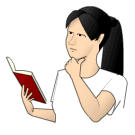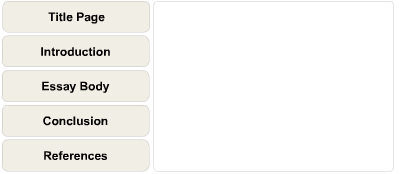Critical thinking is often mistaken for a related, but quite distinct, sense of finding fault or being negative. However, in an learning environment, being critical means:
A person who thinks critically can ask appropriate questions, gather relevant information, efficiently and creatively sort through this information, reason logically from this information, and come to reliable and trustworthy conclusions about the world. |
 |
- read widely on the topic, preferably beyond the course material (eg articles, reference books, reputable websites etc)
- understood what you have read
- understood and discussed the main issues of the set topic
- presented a clear, reasoned argument that reaches a logical conclusion
Written assignments that are based on an essay format use the following structure. Click on each of the following elements of an essay to reveal what is should contain:
|
- identifying and understand the directive words (eg examine, explain, interpret) that frame the topic or question
- recognizing and understanding the key terms specific to the topic
- brainstorming the topic to generate ideas and possible ways of approaching the topic.
- read over your notes and ideas that you have accumulated during your brainstorming sessions
- note down relevant headings or phrases
- how does this point or idea relate to the topic?
- how does this help to answer the question?
After you have identified the key ideas the next step is to think about how they can fit together to make up a coherent argument, explanation, or description. This list of ideas or headings will form the body of your essay. Your final introduction and conclusion will eventually grow out of the structure and content of the body.
To maintain a focus on answering the question, it may be useful to formulate a one-sentence summary of the main claim of your essay. If you find this difficult, it may indicate that additional brainstorming is required.You will be required to identify and acknowledge the exact sources of any information, ideas and quotations that you have used to produce your essay.
There are four important reasons for referencing your material:- to support a specific point, claim or argument.
- to give credit to the source of your ideas and avoid plagiarism
- to comply with copyright law
- to enable your reader to find the exact edition of the work that you consulted
The following examples illustrate one style of referencing, the Harvard Referencing system, as it applies to several different types of resource:
1. Quotations
Quotations shorter than 30 words can be integrated into the text of your essay but must be placed within single quotation marks.
In exploring this distinction, Bertels and Savage (1998, p.19) suggest that ‘…learning can be understood as a process, knowledge as a result of that process'. |
Quotations that are more than 30 words are not enclosed within quotation marks. They must be set apart in the text by indenting the entire quote on the left hand side and be introduced by a colon, as in the following example:
As noted by Borghoff and Pareschi (1997):
|
2. In Text References
For in text references, always give the relevant page number(s) whenever you quote or paraphrase information found in a print source such as a journal article, book, government publication or conference proceedings. This makes it easier for someone to find the relevant passage within the publication.
A recent study (Beldon, Juniper & Marcus 2000, p.73) found... |
3. Reference List
Always include a reference list at the end of your assignment detailing each work already referred to in your essay. Do not include any additional sources in this list, unless your trainer has specifically asked for a bibliography .
Works in a reference list (or bibliography) are listed in alphabetical order by author name (or by title where there is no author).| Single Author | Wenger, E. 1998, Communities of Practice: Learning, Meaning and Identity, Cambridge University Press, Cambridge. |
| Multiple Authors | Beldon, D, Juniper, F & Marcus, D 2000, eLearning Principles , Microsoft Press, Washington DC. |
| No Author | Social Marketing , 2002, Academic Press, San Diego , California. |
| Single Volume of a Multi-Volume Work | Lourdes , M (ed) 1999, Marketing in the internet economy , vol. 2, Handbook of marketing, Springer, Berlin. |
| Journal Article | Seely Brown J. and Duguid P. 1998, Organizing Knowledge, California Management Review , vol. 40. no. 3, pp. 90- 111. |
| Conference Paper | Meehan, J. 1999, Knowledge Management: A case of quelling the rebellion?, Critical Management Studies Conference July 1999 , Liverpool John Moores University , Liverpool. |
| Document on the Internet | Zimmerman, R. 1999, Social Marketing Strategies for Campus Prevention of Alcohol and Other Drug Problems , [Online], Available at: http://www.edc.org/hec/pubs/soc-marketing-strat.html [Accessed on 18 July 2000]. |
